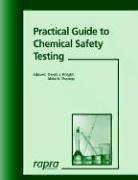Download Practical Guide to Chemical Safety (Rapra Practical Guides) PDF Free - Full Version
Download Practical Guide to Chemical Safety (Rapra Practical Guides) by D J Knight, M B Thomas in PDF format completely FREE. No registration required, no payment needed. Get instant access to this valuable resource on PDFdrive.to!
About Practical Guide to Chemical Safety (Rapra Practical Guides)
There are many different chemicals and materials in use today. These are subject to stringent regulations, which include a requirement for physico-chemical and toxicity testing. In some countries existing chemicals are also undergoing safety checks. The aim is to determine their hazardous properties and the risks involved in using substances. Health and safety of the environment and the individual are becoming of prime importance to society and extensive legislation has been developed. To the R&D chemist this is a maze to negotiate when trying to introduce a new material or chemical into a different market place. What tests are required and for which markets? What do the test results mean? Who are the key organisations in each global region? Legislation varies between applications and often the quantity of chemical in use is critical to determining the level of testing required. A Practical Guide to Chemical Safety Testing describes the different tests that must be performed on new chemicals and other materials to demonstrate to the regulatory authorities that they are safe for use. Tests vary from physico-chemical, measuring properties such as melting point and density, through genetic toxicity studies, to mammalian toxicology and studies to investigate effects on the environment. Animal testing is carried out to look for potential irritants, harmful substances, corrosive agents, allergens, cancer causing potential, etc. Each test type is described here and the validity of the test methods is debated. For example, there are sometimes major differences between simple model systems using cell lines or bacteria, effects in laboratory animals and, most importantly, with effects on humans. This can give rise to misleading interpretation of results. There is a chapter devoted to alternatives to animal testing for safety evaluation. Many non-animal screening tests are available. It is also becoming increasingly possible to cross-match many new chemicals with existing toxicity data to predict potential carcinogenicity, allergenicity, etc. These approaches can reduce the test requirements for the chemical, although a structural alert showing the presence of a suspect chemical moiety can trigger definitive toxicological assessment. Ecotoxicological testing is carried out to determine the level of hazard to organisms in the environment. Important properties used to estimate environmental fate include the solubility of the test material in water, its ability to adsorb to soil and its potential for accumulation in animals. Regulations vary depending on the intended purpose of a material, and this book describes the requirements for general chemicals, polymers, food contact materials, medical devices and biocides. Often the quantity imported into a region determines the stringency of the testing required. The EU, the USA, Japan and other geographical regions each has its own set of regulations. These are outlined here. In some instances approval of a chemical in one country will lead to automatic approval in a second country. In other cases new testing is required. This is a very complex situation. The second half of this book sets out to untangle the web of legal issues facing manufacturers and suppliers. This book is essential reading for chemical and material manufacturers and suppliers. It describes clearly the process of obtaining approval for use in a variety of global regions and across different applications. It also explains why different tests are performed and the implications of the results.
Detailed Information
| Author: | D J Knight, M B Thomas |
|---|---|
| Publication Year: | 2003 |
| ISBN: | 9781859573723 |
| Pages: | 479 |
| Language: | English |
| File Size: | 2.595 |
| Format: | |
| Price: | FREE |
Safe & Secure Download - No registration required
Why Choose PDFdrive for Your Free Practical Guide to Chemical Safety (Rapra Practical Guides) Download?
- 100% Free: No hidden fees or subscriptions required for one book every day.
- No Registration: Immediate access is available without creating accounts for one book every day.
- Safe and Secure: Clean downloads without malware or viruses
- Multiple Formats: PDF, MOBI, Mpub,... optimized for all devices
- Educational Resource: Supporting knowledge sharing and learning
Frequently Asked Questions
Is it really free to download Practical Guide to Chemical Safety (Rapra Practical Guides) PDF?
Yes, on https://PDFdrive.to you can download Practical Guide to Chemical Safety (Rapra Practical Guides) by D J Knight, M B Thomas completely free. We don't require any payment, subscription, or registration to access this PDF file. For 3 books every day.
How can I read Practical Guide to Chemical Safety (Rapra Practical Guides) on my mobile device?
After downloading Practical Guide to Chemical Safety (Rapra Practical Guides) PDF, you can open it with any PDF reader app on your phone or tablet. We recommend using Adobe Acrobat Reader, Apple Books, or Google Play Books for the best reading experience.
Is this the full version of Practical Guide to Chemical Safety (Rapra Practical Guides)?
Yes, this is the complete PDF version of Practical Guide to Chemical Safety (Rapra Practical Guides) by D J Knight, M B Thomas. You will be able to read the entire content as in the printed version without missing any pages.
Is it legal to download Practical Guide to Chemical Safety (Rapra Practical Guides) PDF for free?
https://PDFdrive.to provides links to free educational resources available online. We do not store any files on our servers. Please be aware of copyright laws in your country before downloading.
The materials shared are intended for research, educational, and personal use in accordance with fair use principles.

